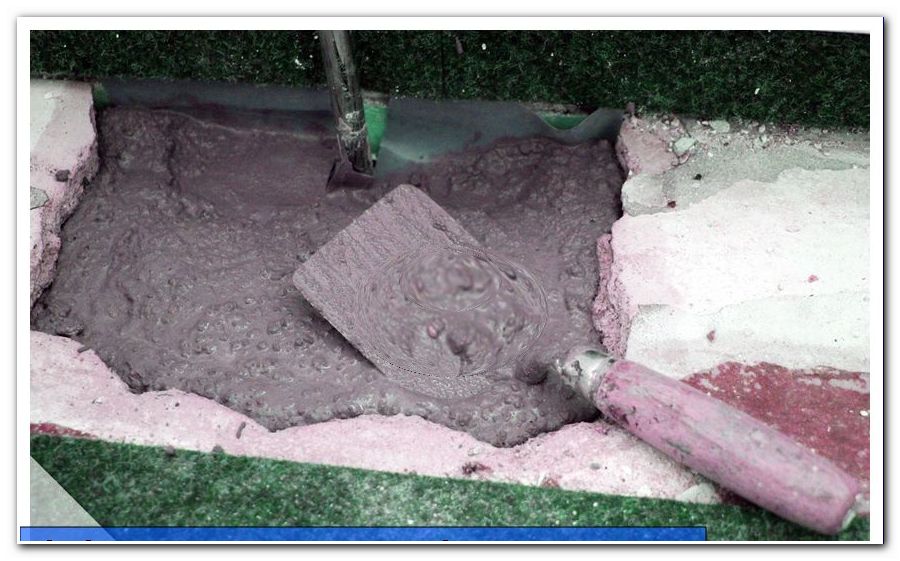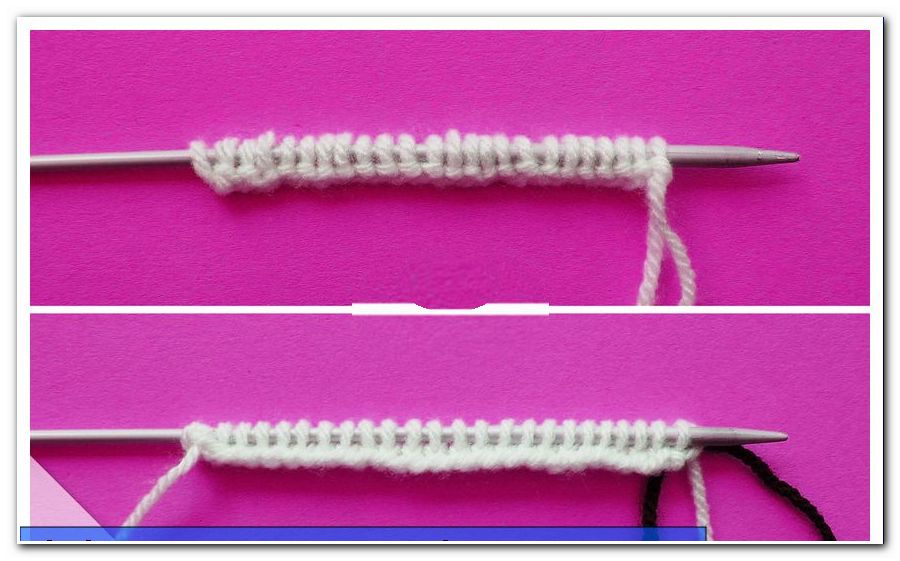Clean Ripped Silver - Effective Home Remedies

- Effective home remedies
- The miraculous silver bath
- 1. Commercially available silver immersion bath
- 2. The homemade silver bath
- Why does silver start? "> Never brush silver again
Brushing silver is a meditation for Zen masters and a nightmare for well-to-do people. Unless you know how to clean silver properly, and you'll find out in this article. You will also learn which home remedies work, why home remedies can also harm the silver and how to prevent tarnishing.
Brushing silver has thoroughly spoiled generations of maids' spirits. Below are listed many home remedies for cleaning silver. You will also learn how to polish silver instead of brushing it off, why silver starts and how you can prevent it.
Effective home remedies
You want to start immediately, preferably with a means that you already have in the house? Please, very much, clean the list of home remedies for silver is impressively long:
- Aluminum foil - wrap, simmer for 1 hour in water
- Ammonia Solution - Ammonia is highly corrosive
- Ash and soda as cleaning paste
- ATA or other cleaner with fine abrasives

- Baking soda - mix with water, put in overnight
- Beer - insert and polish
- Put the buttermilk - silver down and let it rest for a few hours, rinse with hot water and polish dry
- Dentifrice, dissolve tablet in water, insert silver overnight
- Dishwasher: Wrapped in aluminum foil wash with
- Soda as a cleaning paste
- Raw potato cleans silver by rubbing
- Salt on the silver part, add a little lemon juice, polish, rinse, dry rub
- Sour milk - place silver pieces overnight, rinse with water the next morning
- Whiting chalk from the pharmacy as a fine abrasive

- Turpentine - apply with a cloth and polish
- Toothpaste - leave to act for a short time, rub off with an old toothbrush and rinse off with water, polish again

The miraculous silver bath
More surface-friendly than by abrasion (abrasion), the layer on the silver is removed by reduction. "Brutal" reduction by a silver cleaning agent / bath from the trade or gentle, constructive reduction by a silver bath composed by itself and with budget funds:
1. Commercially available silver immersion bath
Commercially available silver immersion baths are real powerhouses that chemically transform the silver compounds formed during start-up into water-soluble complex compounds. They do this with a mixture of highly aggressive substances such as sodium thiosulphate, ammonia, thiourea, nonionic surfactants, hydrochloric acid, sulfuric acid.
The silver parts are dipped in the highly aggressive solution prepared according to the instructions for use, then rinsed off and dried. The baths attack the silver and are extremely harmful to the environment and to health. When the dipping time is coated or a silver article has layers of different thicknesses, this mixture dissolves the silver into the unoxidized substance.
Even liquid silver cleaning agents, pastes, powders are usually complexing agents. If they are to act, it indicates in this case that a chemical reaction should take place here. They then contain the corresponding hazardous substances and sometimes also abrasives and other (usually unnecessary) cleaning agents.
Conclusion: Stay away from commercially available silver dips and silver cleaning agents.
2. The homemade silver bath
Smarter than "brushing off silver" is certainly "silver on it", and that also works through a chemical reaction. However, it can be triggered with simple home remedies:
Hot water with soda or common salt, some acid (lemon, vinegar) and aluminum (aluminum foil) reduces the oxidized layer on the silver, but does not dissolve into the water or is cleaned off with the cleaning paste, but becomes on the silver article itself of silver sulfide converted back to silver.
1 of 4



Silver and aluminum form an electrochemical short-circuit element, current flows between aluminum and silver, the aluminum corrodes (decomposes), the silver forms hydrogen, which reacts with the silver sulfide and re-forms it into silver.
Make silver bath yourself:
- Strong odor load possible, pay attention to good ventilation
- Bring 1 liter of water to boil with 6 tablespoons of cooking salt or soda
- Put loose crumpled aluminum foil in it
- Aluminum foil must be free of plastic coating
- Holding or laying a silver object must be in contact with the aluminum
- In a short time the silver object lightens up
The sulfur compounds are to smell and the aluminum foil is dark. The silver must now be quickly taken out of the bathroom, as the regression of the pad accelerates and someday even pure silver ions dissolve.
The aluminum silver bath reaches its limits with fine jewelery and the like, because the chance of contact between the aluminum foil and silver everywhere decreases enormously on diverse, irregular surfaces. For chains and other pieces with solder joints z. B. each member have contact with the aluminum foil, because the electron flow at the phase boundaries (solder joints) is usually disturbed. Such pieces are best cleaned with the right ultrasonic cleaner, unfortunately no home remedy and anyway a separate topic.
Why does silver come on "> 
In our environment, silver does not only come into contact with pure air, but the air contains some trace gases, the proportion of which has been increased by human action.
Sulfur dioxide turns into hydrogen sulfide and oxygen with water. If silver comes into contact with one of these sulfur compounds, it starts. The unsightly coating consists of silver sulfide and silver chloride. Trigger for the start can be:
- moist air
- human skin
- Tap water (chlorine)
The reasons for starting are certainly of practical interest. Knowing what needs to be brushed off and what this substance is reacting to is easier to fathom, which is the best way to get rid of it without damaging the silver itself.
When a silver particle oxidizes, it dissolves from its solid metal lattice and lies rather loosely on the silver piece. If the home remedy used for silver cleaning works abrasive, ie rubbing or grinding, the dissolved silver compound with cleaning cloth and cleaning agent is simply brushed away / wiped off the silver object. As a result, the silver decreases with each brushing, but only in the molecular range, but a silver spoon is also noticeably thinner over time. If the cleaned silver pieces are only silvered, the silver coating is sometimes worn very quickly.
In addition, each black-stained abrasive patch leaves fine scratches or imperceptible indentations in the silver surface. This increases the vulnerable area.
Some home remedies remove the coating by sanding, others by chemical reactions. Actually one would first have to find out how the chemical agents work before they are allowed to act on the silver. The denture cleaner consists z. From 20 different ingredients that may possibly react with the silver.
Never brush silver again
As I said, the silver coating arises because the surface of the silver objects with the sulfur in air, skin moisture, food, etc. reacts. Since silver is processed by humans (since about the 5th millennium BC), attempts are made to stop the tarnishing early.
You could cover items that are lightly touched or touched (cups, bowls, platters, vases, etc.) with a thin coat of paint that protects against air contact. Buy from a specialist retailer and ask for a suitable, and possibly food grade, varnish that is suitable for silver.
Only occasionally used silver cutlery and utensils can be rubbed thinly with glycerin before packing away as tarnish protection. 
You could also try to keep silverware and dishes from getting in contact with sulfur-containing foods, which will produce deposits even faster than air. Sulfur-containing foods, however, contain very many (powerful) 50 to 400 mg of sulfur per 100 g:
- nuts
- Shellfish
- goose meat
- caviar
- shrimp
- Fish and cuttlefish
- Meat, liver
- soybeans
- cress
- Cabbage and onions
Pack your silver in the traditional upholstered, tight-fitting cutlery box or wrap it in soft cloths or paper towels and store it in a drawer. Plastic bags are not suitable, but may promote condensation through condensation.
Add a " sulfur absorber " that filters the hydrogen sulfide from the air because it reacts more easily with this substance than with silver. These may be a few copper pennies (cent pence) or impregnated starter cloths from the home goods business.
Next, you can put a few pieces of chalk or silica gel pouches (from the packaging of electronic devices or the shoebox), these also delay tarnishing by absorbing moisture.





